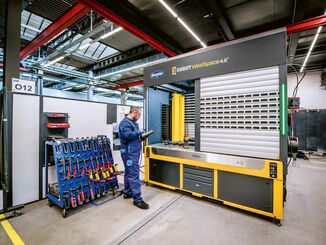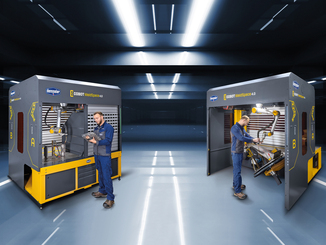
Simply set it up at the desired location and start welding: The Cobot WeldSpace 4.0 is easy to operate and, according to manufacturer Demmeler, delivers “top welding results”.
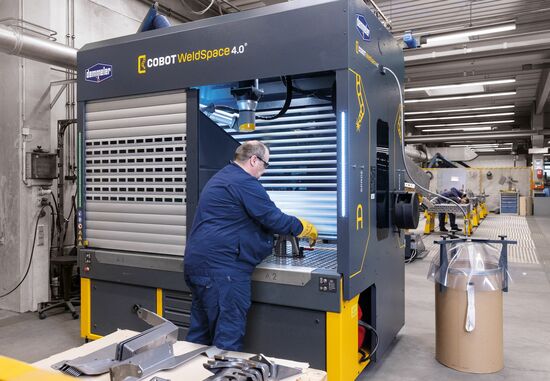
© Demmeler
Welders are currently in greater demand than ever before, and the job market is empty. Carsten Stein, Managing Director of Schulz Fördersysteme GmbH in Thuringia, is well aware of this. This makes it all the more important for him to make optimum use of his qualified workforce in order to be able to service the full order books. The solution was partial automation of the manual welding workstations, which is easy to program and profitable even for small batch sizes.
For several months now, the company has been relying on a new Cobot system in addition to a Demmeler manipulator and rail system. The Cobot WeldSpace 4.0 handles arc welding of S235/S355 and S420 steel assemblies.
Complete package for a quick start in automated welding
With the new cobot line from Demmeler, Schulz Fördersysteme can react flexibly to changes in component geometries or sizes quickly and easily in production. All welding programs and parameters stored in the Demmeler Cobot WeldSpace 4.0 can be retrieved for the next job. “We are, contrary to our name, a contract manufacturer with a focus on sheet metal working for a wide range of industries: Automotive, Railway, Mechanical and Plant Engineering, Materials Handling, Furniture Industry as well as Metal Construction. Our flexibility has always been one of our greatest strengths compared to the competition,” says Carsten Stein.
Due to the extremely simple operation, no programming knowledge is required. The operator only has to move the cobot by hand to the place where welding is to take place. Intermediate waypoints and sections are also programmed in this way at the touch of a button. Without many windows and submenus, professional welding programs can be created intuitively and quickly with just a few clicks.
“We already have several fully automated welding workstations equipped with a classic industrial robot. The big disadvantage for us was always the time-consuming programming and the long learning curve for the employees. With the Cobot WeldSpace 4.0 from Demmeler, this is no longer an issue.”
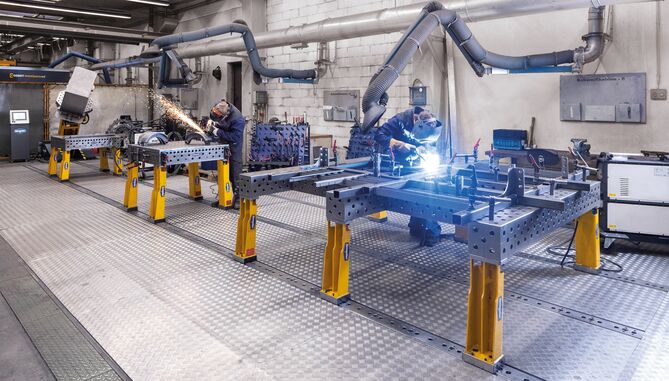
© Demmeler
Parallel welding, setup and reclamping
Schulz Fördersysteme specializes in metal processing. In addition to sheet metal parts, folded parts and complex welding and assembly assemblies, the company also manufactures components for conveyor systems. Around 100 employees work at the Geratal site in Thuringia under the Schulz Fördersysteme and Blechbearbeitung Thüringen brands. The fact that the company sees itself as a system provider with a high level of vertical integration is also reflected in its modern production processes.
“Our goal was to deliver better quality at at least the same cost and, due to the labor market situation, with less qualified personnel. The advantage is that, due to automation, it no longer depends on the dexterity and personal skills of a single person. When it comes to setting up the machine and quality control, the specialist is of course indispensable. But to load the programmed cobot, the machine operator no longer has to be a 100 percent welder,” explains Stein.
With the Demmeler Cobot WeldSpace 4.0, several, sometimes different parts can be welded simultaneously. The automatic movement of the enclosure allows working in multi-station mode. While the robot is welding on one side, the operator, protected by retractable rolling doors with aluminum armor and integrated welding protection glass, can set up and reclamp on the other side in parallel (two-station operation).
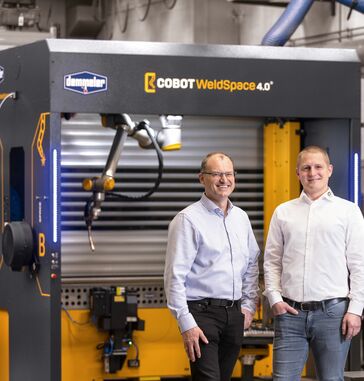
© Demmeler
A further, optional division of the front workspace (SPACE A) by means of a partition even creates an additional workstation (three-station operation). In order to reach all work areas easily, the Cobot is mounted centrally on the ceiling and travels with the enclosure. In addition to ease of programming, the physical strain on welders should be minimized.
“It was important to us to relieve our employees. Welding is a demanding job. Often our welders are forced to work in constrained positions, because the welds are often in hard-to-reach places,” reports Stein. For this reason, the rear workstation (Space B) of the Cobot system was equipped with a two-axis manipulator: Workpieces weighing up to 500 kg can be easily positioned in an optimal tub position. Time-consuming reclamping of workpieces is no longer necessary and thanks to the rotary axis (axis 2) of the manipulator, even circumferential welds can be welded.
As a certified specialist company according to DIN EN 15085-2 for the production of highly safety-relevant CL1 components for rail vehicles, Schulz Fördersysteme has a special responsibility. This standard is the basis for the welding of metallic materials in the manufacture and repair of rail vehicles and parts and specifies the quality requirements for the construction of new rail vehicles and their repair. “All welds must meet the highest quality standards,” Stein explains. In the future, he could also imagine manufacturing the rail vehicle parts with the help of the Demmeler Cobot WeldSpace 4.0. “The welding result really convinced us and with the stored welding jobs, the welds are also reproducible.”
Demmeler Cobot WeldSpace 4.0 contains numerous templates for optimized standard welding processes, so-called welding jobs, matched to power source, welding process and torch. Via the Demmeler Cobot interface, the operator can access and select the stored programs of the welding machine with all important welding characteristics and parameters of the job library. Satisfied all around “Demmeler offers a wide range with a lot of potential, which can also be used for the production of small and medium batch sizes. We appreciate the very good quality of Demmeler products – and the good service!”. Robert Zeilinger from Mauersberger Industrievertretungen can also confirm this. As a Demmeler sales partner, he has plenty of experience in the field of welding process automation: “Compared to manual welding, the Demmeler Cobot WeldSpace 4.0 is significantly faster, reducing processing time by at least 30 percent.”
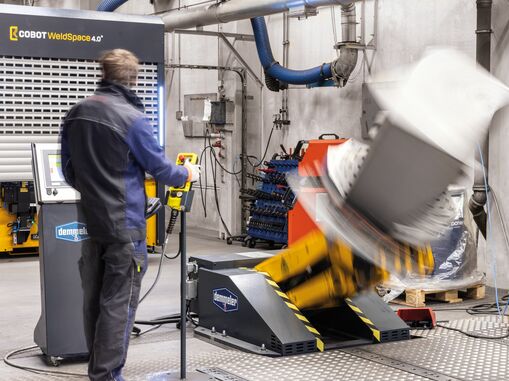
© Demmeler
Optimization of manual welding workstations
Schulz Fördersysteme also relies on innovations from Demmeler when it comes to optimizing manual welding workstations. In order to quickly switch between small and larger assemblies, two rail systems were installed. This allows the workstations to be changed flexibly. On sliding feet, both Demmeler 3D welding tables and spacer brackets are positioned on the rail system according to the workpiece size. “For example, if needed, we have one large workstation or several small ones, depending on the dimensions of the assembly,” Stein said.
When clamping the workpieces, the rollers of the patented Demmeler sliding feet sink through the load. This gives the foot a planar contact with the foundation rail. The welding current is not conducted via the track rollers and thus the bearing is not damaged. Different setup heights can be easily adapted to the workpiece by using different table foot heights. “With the shift system, we’ve been able to significantly increase repeatability while reducing our fixture costs.” The modularity and flexibility of the system also reduces setup times for the different types of components.
For components such as battery troughs and hoods, which have to be rotated several times due to the position of the weld seams, the Ergonomix M manipulator from Demmeler takes over the heavy work. The special feature of the product family is the large swiveling range of 180°: “This allows us to finish machining our workpieces in one setup and without additional turning, which saves a lot of time.”
Since the tiltable manipulator can be adjusted in height and angle at the touch of a button, Schulz Fördersysteme thus also creates an ergonomic working environment for manual welding workstations with this handling device. This is because the manipulator enables very precise work with optimized welding sequence, which significantly reduces the welding distortion rate. Carsten Stein is convinced: “We will continue to invest in the automation of our production in order to counter the shortage of skilled workers and to be able to react even more flexibly.”
Background
Innovations that became the standard for craft and industry have always characterized Demmeler’s successful company history. With intelligent products that significantly increase efficiency and significantly improve occupational safety. As an important milestone, Demmeler set the standard on the market as early as 1990 with the invention of the 3D clamping system and 3D welding table D28: Originally intended for the company’s own production, the fixture system proved to be a quantum leap for metal processing and today counts as the international standard for trade and industry due to the enormous number of application and combination possibilities. As a hidden champion, the company develops and manufactures products in the field of clamping and welding technology, rotary tables, robot-based tool changing systems and machine tool components at its Heimertingen site.
Web:
www.demmeler.com

